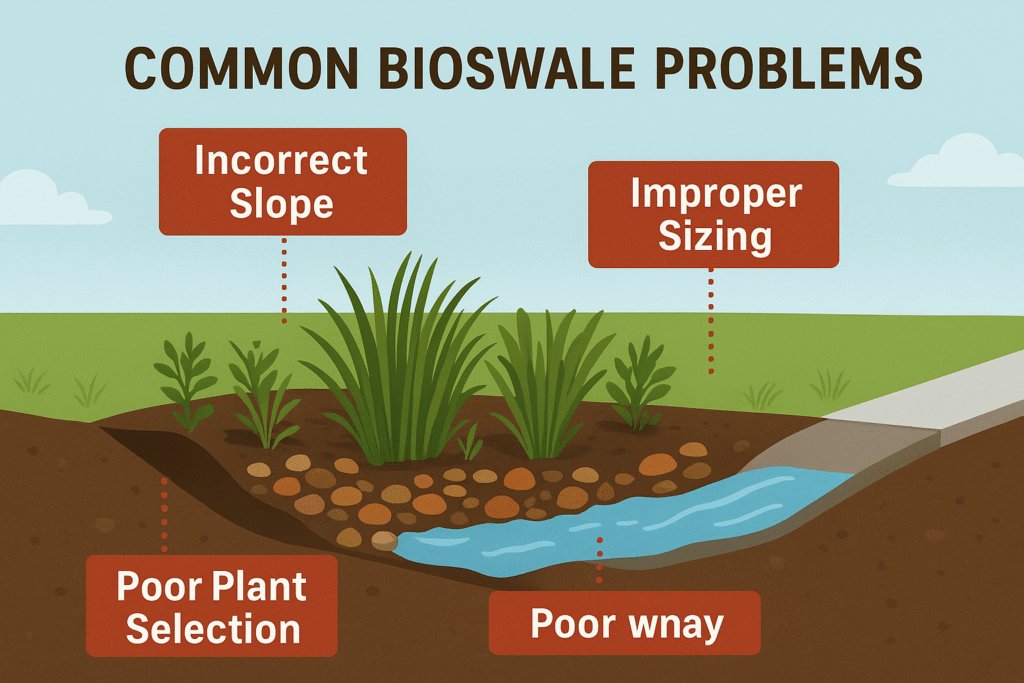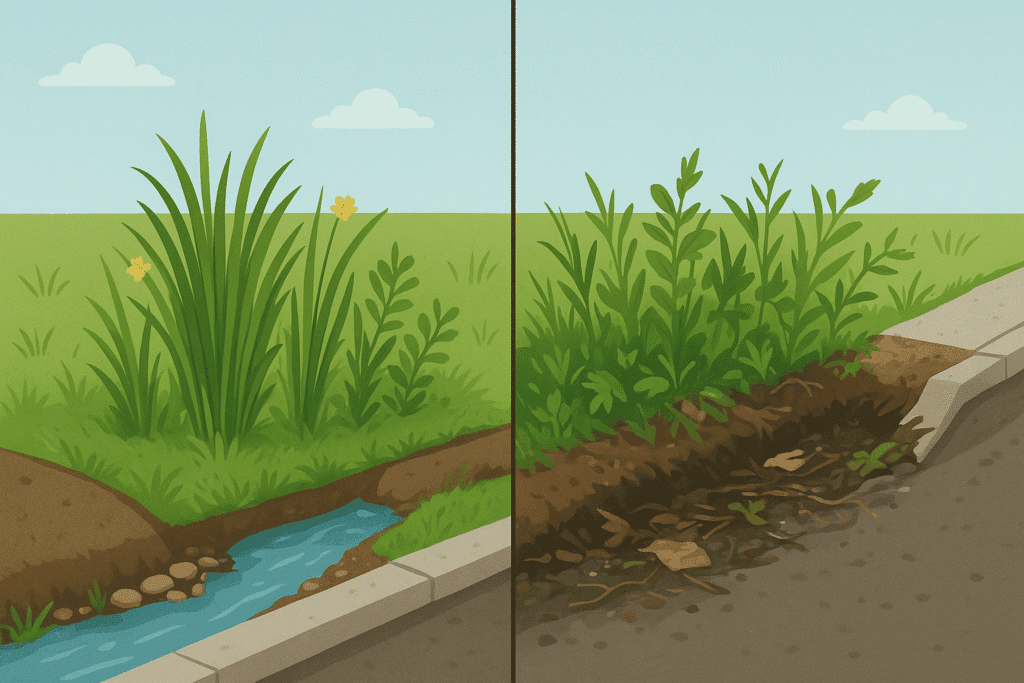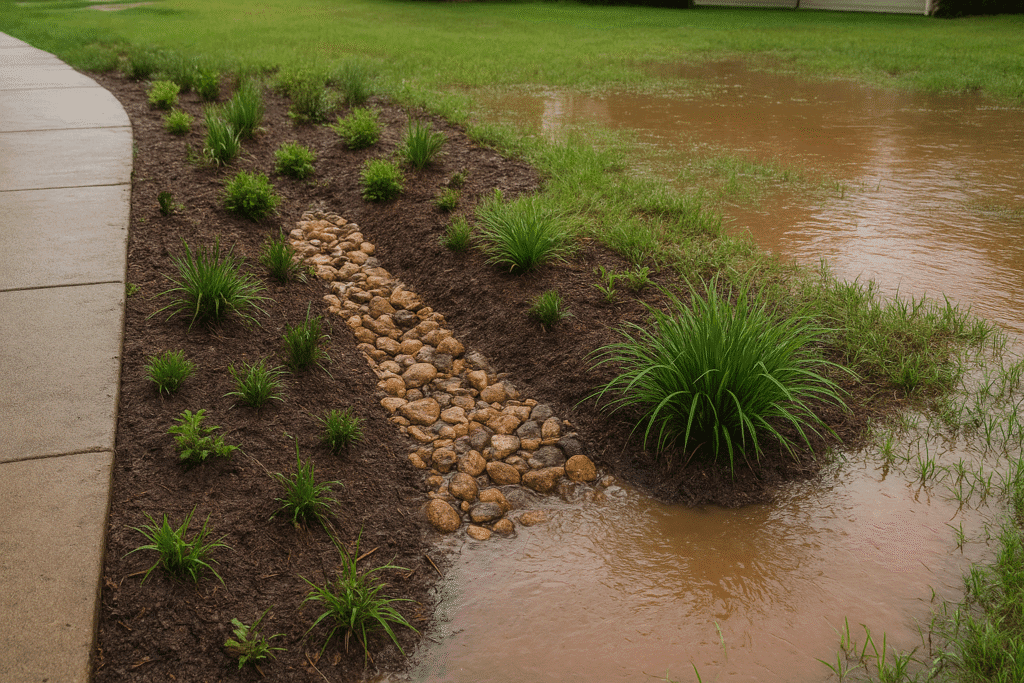
Table of Contents
ToggleCommon bioswale problems and why they matter?
Bioswales are one of the simplest and most affordable green solutions for handling stormwater. Yet they don’t always work according to our expectations. Many home owners and even small projects face common bioswale problems like clogging, erosion or plants dying early. These issues happen because of poor planning or small mistakes in bioswales design during set up. But most of them you can avoid by just knowing the root causes.
The biggest reason bioswales fail is that people underestimate water flow. When heavy rain comes, an undersized bioswale can overflow that eventually causes floodings in the same area where it was supposed to protect. Another frequent challenge is soil compaction or the wrong material mix which prevents water from soaking properly. Overtime, this creates standing water and mosquito breeding spots.
Plant selection is another factor. Choosing non native or delicate plants often leads to vegetation failure in bioswales. Soil erodes and bioswale loses its purpose without strong root systems. Similarly, lack of maintenance like ignoring weeds or not checking for blockages, can create bigger issues.
Understanding these common bioswale problems is the first step before building a system that lives long. By learning from past mistakes you can design, install and maintain a bioswale that works during heavy run and supports local plants with improving your yard’s landscapes. This article will show you each common bioswale mistakes in detail and their solutions.

Site Selection Mistakes in Backyard Bioswales
One of the most overlooked causes of common bioswale mistakes is poor site selection. The wrong spot for your bioswale can lead to flooding, soil erosion and even plant failure. Many homeowners pick areas based on convenience rather than slope, drainage patterns or sun exposure which often backfires.
The ideal bioswale site has a gentle slope of about 1-6%. If sloop is more then water will run too fast that erodes soil, and if it is too flat then water pools that causes clogging and stagnation. Checking underground utilities is another critical step. Accidentally placing a bioswale over pipes or septic lines can be costly and dangerous, hence you should ask your local authorities first.
Soil type also matters. Heavy clay soils hold too much water while sandy soil drain too quickly. So, to prevent bioswale clogging issues you have to pic a location that naturally supports the water flow. Sunlight exposure is equally important because some native plants require partial or full sun to thrive otherwise vegetation will fail in bioswales.
Finally, consider accessibility for maintenance. If your bioswale is tucked into a hard-to-reach corner then simple tasks like weeding or removing debris become difficult. It increases the chances of common bioswale problems over time. That’s why proper planning at this stage ensures a bioswale that not only looks good but also performs efficiently and lasts for years.
Sizing problem in Bioswales
One of the most common causes of bioswale problems is their incorrect sizing. A bioswale that is too small cannot handle the amount of water flowing into it which can lead to overflow and even flooding in your yard. On the other hand, a bioswale that is too large may hold too much water for too long and it will create stagnant conditions that harm plants and attract mosquitoes.
The size of a bioswale should match the area it is draining. For example, backyard with a large roof or paved area will produce more runoff and that’s why bioswale must be wide and deep enough to handle heavy rain. As earlier discussed, soil type also plays a role- design of bioswale may be different due to different kinds of soil.
Another factor is rainfall intensity. Areas that get frequent heavy rains need bigger bioswales to prevent overflow, whereas areas with lighter rain can manage with small designs. Vegetation also affects sizing; dense plants slow down water movement and increase infiltration that helps the bioswale to handle more water efficiently.
Simple sizing mistakes can turn your bioswale into a source of problems rather than a solution. Always plan carefully by observing water flow, considering soil type and matching the bioswale to the runoff from your property.

Material Mix issues in Bioswales construction
One of the less discussed but a common cause of bioswale problems is using the wrong mix of materials. The soil, gravel and sand you use in a bioswale directly affect how water flows and absorbed. If the materials aren’t balanced then water can pool on top or pass too quickly that reduces the effectiveness of bioswale.
A frequent mistake is using heavy clay soil without enough sand or organic matter. Clay can hold water but drains slowly that causes standing water. This standing water will encourage mosquito breeding and it can drown plants. Moreover, if you use sands and gravel only then it can cause fast water flow that washes soil away and harm vegetation. That’s why the ideal mix is usually half native soil and half sand or composted material which ensures good drainage.
Gravel is often used at the bottom of a bioswale to aid infiltration but too much gravel can clog the system if it is not layered properly. Similarly, mulch on the surface helps to reduce erosion but using it incorrectly can block water from entering the soil.
By using the right materials in the correct proportion we can prevent bioswale clogging issues and ensure that the system can handle heavy rainfall with supporting healthy vegetation. Pay attention to this detail during construction because it can save time, efforts and cost in the long run and also makes your bioswale a reliable solution for managing stormwater in your backyard
Perfect plant Choices For Bioswale
Plants are the backbone of bioswales. Many home owners choose non-native or delicate plants that cannot survive the wet-and-dry cycles that are typical for a bioswale. When these plants fail, the soil loses stability and erosion increases. At last, the entire system struggles to manage water effectively.
The right plants for a bioswale are usually native species that can tolerate both standing water after a rain and dry periods between storms. Deep-rooted grasses and perennials (like switchgrass or sedges) can help to hold soil in place and improve water absorption. By using a mix of many plants can help to prevent one type from failing completely.
Another common error is overcrowding plants. At the initial stage it may look less but too many plants compete for nutrients and water which can lead to die-off. On the other hand, planting too sparsely reduces soil stabilization and slow-down water filtration process.
Don’t forget about sunlight requirements. Some plants need full Sun to thrive but other plants prefer partial shade. Ignoring these needs often leads to vegetation failure in bioswales that later turns into erosion and clogged channels. Choosing the right plant species, spacing them properly and understanding their water and sunlight needs ensures a healthy & resilient bioswale.

Installation problems of bioswale
Many bioswales fail during installation because of small but costly mistakes, even with right site and design. A major issue is poor shaping of the channel. Water flows unevenly if the base isn’t level and it will cause erosion in one area while the other parts will be dry. Another frequent problem is skipping edging. Without sturdy borders (made from log or rocks) soil washes away during the first heavy rain.
Some DIY builders also forget to compact the layers properly. Laying down mulch too thick creates a barrier that blocks infiltration instead of helping it. Another mistake is planting too early or too late in the season. If vegetation becomes vulnerable to weeds and erosion.
Take your time to follow each step- grading slope, layering materials correctly, adding proper edging and planting at the right season. All these small steps can prevent common bioswale problems. Careful installation ensures a good looking bioswale that works for many years.
Maintenance Oversights That Damage Bioswales
A bioswale isn’t a “build it and forget it” solution. Many systems fail simply because they don’t get the regular care that they need. One common oversight is ignoring weeds. Invasive plants spread quickly, they choke out native species that stabilize soil and filter water. Another issue is not removing debris. Leaves, trash and sediment build up in the channel leads to bioswale clogging issues that block water flow.
Many of us skill seasonal checks. Without inspecting after heavy rains small ruts or erodes spots can grow into bigger problems. Don’t neglect to replace dead plants because bare soil patches can quickly erode and reduce the bioswale’s ability to absorb water. Even forgetting to refresh mulch every year can leave soil exposed.
Regular and simple upkeep like quarterly weeding, clearing blockages, replanting where needed and inspecting edges can prevent long term Common bioswale problems. By just few hours of care each season we can make bioswale more strong. According to the U.S. EPA, some BMPs successfully infiltrate or remove up to 50 % of stormwater volume. One of these BPM (best management practice) includes bioswales.
Faqs
What are the most common bioswale problems homeowners face?
The most common bioswale problems include clogging from debris, erosion due to poor edging and vegetation failure when non native plants are used. These issues usually happen because of design mistakes, poor material choices or skipped maintenance.
How can I prevent common bioswale problems in my backyard?
You can prevent common bioswale problems by choosing the right site with a gentle slope, sizing the bioswale correctly, using a balanced soil mix and planting native species. Regular weeding, clearing blockages and seasonal checks also keep the system working smoothly.
Do bioswales need regular maintenance to avoid problems?
Yes, maintenance is key to avoiding common bioswale problems. Without maintenance issues like clogging, weed growth or soil erosion can damage the system. Simple steps like clearing debris, refreshing mulch and replacing dead plants can ensure long-term performance.
